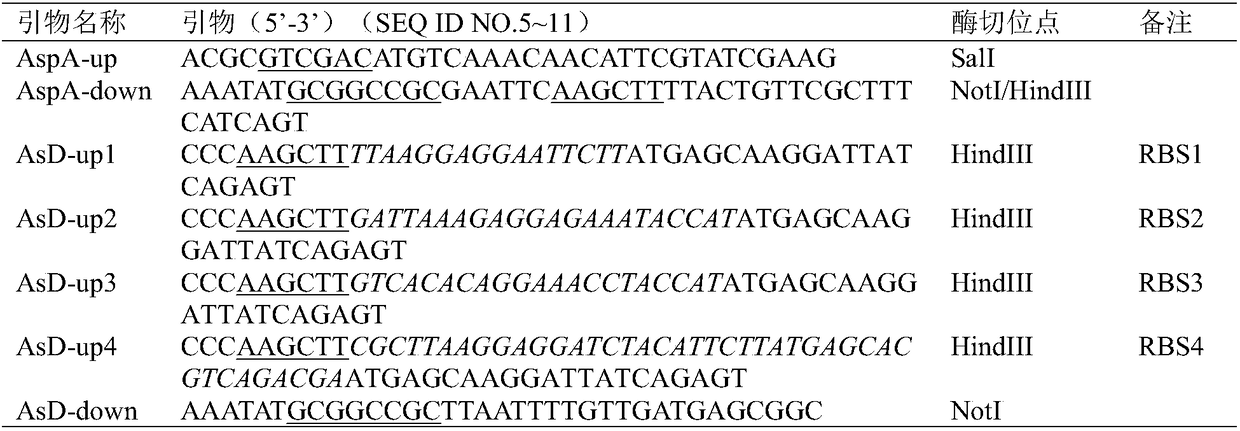Escherichia coli capable of producing L-alanine through fermentation and application of escherichia coli
A technology of Escherichia coli and alanine, applied in the field of bioengineering, can solve problems such as single construction method and complicated genetic engineering operation
- Summary
- Abstract
- Description
- Claims
- Application Information
AI Technical Summary
Problems solved by technology
Method used
Image
Examples
Embodiment 1
[0030] Embodiment 1: Construction of dual enzyme co-expression strain
[0031] (1) Use the bacterial genome extraction kit to extract the genomic DNA of Escherichia coli K12 and Comamonas testosteroni;
[0032] (2) Using the primers AspA-up and AspA-down in Table 1 to clone the aspA gene from Escherichia coli genomic DNA, use SacI and NotI double digestion and connect it to the expression vector pETac to obtain pETac-aspA;
[0033] (3) According to the statistical linear relationship between RBS intensity and the expression of the regulated protein, design RBS1, RBS2, RBS3, and RBS4 to regulate the expression intensity of the two enzymes, and use primers AsD-up1 and AsD-down, AsD-up2 and AsD -down, AsD-up3 and AsD-down, AsD-up4 and AsD-down were obtained by cloning the asD gene from the genomic DNA of Comamonas testosteroni;
[0034] (4) After the sequence of the 4 segments of asD gene obtained by the above clone is correct, use HindIII and NotI double restriction enzymes to ...
Embodiment 2
[0042] Embodiment 2: Construction of high-production L-alanine Escherichia coli
[0043] Using the principle of Red homologous recombination, a constitutive promoter J23119 (BBa23119) was added upstream of the YgaW genome to enhance the expression of AlaE protein and promote the conversion of L-alanine from intracellular to extracellular.
[0044] (1) Use the software Primer Premier 5 to design homologous recombination primers (as shown in Table 3), use Kan-S and Kan-A as primers, and pKD4 as a template to amplify the kan gene, and use YgaW-S and YgaW-A as primers, The Escherichia coli K12 genome was used as a template to amplify the YgaW gene, and the Kan+YgaW fragment was obtained by fusion PCR, which was connected to PMD19 for gene sequencing;
[0045] (2) Using 119-S and YgaW-A as primers, connecting and sequencing the correct Kan+YgaW fragment PMD19 plasmid as a template, and PCR to obtain a knockout frame with homology arms, J23119 promoter, and Kan gene;
[0046] (3) T...
Embodiment 3
[0052] Example 3: Fermentation of E.coli P-119 to produce L-alanine
[0053] Seed medium composition: yeast powder 5g / L, peptone 10g / L, NaCl 5.0g / L, MgSO 4 ·7H 2 O 1.0g / L.
[0054] Fermentation medium composition: initial glucose 70g / L, yeast powder 5g / L, tryptone 2g / L, (NH 4 ) 2 SO 4 2g / L, K 2 HPO 4 12H 2 O 4g / L, KH 2 PO 4 4g / L, MgSO 4 ·7H 2 O 0.5g / L, citric acid monohydrate 0.3g / L, MnCl 2 4H 2 O0.08g / L.
[0055] Pick an appropriate amount of E.coli P-119 from the slant and inoculate it in the seed medium, culture it with shaking at 35°C and 200rpm for 10-12 hours, inoculate the shake flask seeds in the fermenter according to 10% inoculum amount, and fill the medium in the 5L fermenter The volume is 3L, dilute sulfuric acid and ammonia water control the fermentation pH to 6.8-7.2, the ventilation rate is 0.5vvm, the temperature is 35°C, and the stirring is 100rpm. When the OD600 reaches 25-30, add 2g / L lactose to induce aspartase and asparagine Amino acid-β-dec...
PUM
 Login to View More
Login to View More Abstract
Description
Claims
Application Information
 Login to View More
Login to View More - R&D
- Intellectual Property
- Life Sciences
- Materials
- Tech Scout
- Unparalleled Data Quality
- Higher Quality Content
- 60% Fewer Hallucinations
Browse by: Latest US Patents, China's latest patents, Technical Efficacy Thesaurus, Application Domain, Technology Topic, Popular Technical Reports.
© 2025 PatSnap. All rights reserved.Legal|Privacy policy|Modern Slavery Act Transparency Statement|Sitemap|About US| Contact US: help@patsnap.com



